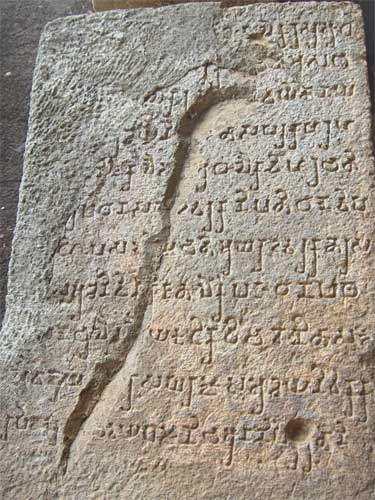|
Visarga
Visarga ( sa, विसर्गः, translit=visargaḥ) means "sending forth, discharge". In Sanskrit phonology ('' ''), ' (also called, equivalently, ' by earlier grammarians) is the name of a phone voiceless glottal fricative, , written as: Visarga is an allophone of and in pausa (at the end of an utterance). Since is a common inflectional suffix (of nominative singular, second person singular, etc.), visarga appears frequently in Sanskrit texts. In the traditional order of Sanskrit sounds, visarga and anusvāra appear between vowels and stop consonants. The precise pronunciation of visarga in Vedic texts may vary between Śākhās. Some pronounce a slight echo of the preceding vowel after the aspiration: will be pronounced , and will be pronounced . Visarga is not to be confused with colon. Types The visarga is commonly found in writing, resembling the punctuation mark of colon or as two tiny circles one above the other. This form is retained by most India ... [...More Info...] [...Related Items...] OR: [Wikipedia] [Google] [Baidu] |
Shiksha
''Shiksha'' ( sa, शिक्षा IAST: ISO: Śikṣā) is a Sanskrit word, which means "instruction, lesson, learning, study of skill".Sir Monier Monier-WilliamsSiksha A DkSanskrit-English Dictionary: Etymologically and Philologically Arranged with Special Reference to Cognate Indo-European Languages, Oxford University Press (Reprinted: Motilal Banarsidass), , page 1070 It also refers to one of the six Vedangas, or limbs of Vedic studies, on phonetics and phonology in Sanskrit. ''Shiksha'' is the field of Vedic study of sound, focussing on the letters of the Sanskrit alphabet, accent, quantity, stress, melody and rules of euphonic combination of words during a Vedic recitation. Each ancient Vedic school developed this field of ''Vedanga'', and the oldest surviving phonetic textbooks are the ''Pratishakyas''. The ''Paniniya-Shiksha'' and ''Naradiya-Shiksha'' are examples of extant ancient manuscripts of this field of Vedic studies. ''Shiksha'' is the oldest and the first ... [...More Info...] [...Related Items...] OR: [Wikipedia] [Google] [Baidu] |
Lao Script
Lao script or Akson Lao ( lo, ອັກສອນລາວ, links=no ) is the primary script used to write the Lao language and other minority languages in Laos. Its earlier form, the Tai Noi script, was also used to write the Isan language, but was replaced by the Thai script. It has 27 consonants ( ), 7 consonantal ligatures ( ), 33 vowels (/ ), and 4 tone marks ( ). The Lao alphabet was adapted from the Khmer script, which itself was derived from the Pallava script, a variant of the Grantha script descended from the Brāhmī script, which was used in southern India and South East Asia during the 5th and 6th centuries AD. Akson Lao is a sister system to the Thai script, with which it shares many similarities and roots. However, Lao has fewer characters and is formed in a more curvilinear fashion than Thai. Lao is written from left to right. Vowels can be written above, below, in front of, or behind consonants, with some vowel combinations written before, over, and after. Sp ... [...More Info...] [...Related Items...] OR: [Wikipedia] [Google] [Baidu] |
Thai Alphabet
The Thai script ( th, อักษรไทย, ) is the abugida used to write Thai, Southern Thai and many other languages spoken in Thailand. The Thai alphabet itself (as used to write Thai) has 44 consonant symbols ( th, พยัญชนะ, ''phayanchana''), 16 vowel symbols ( th, สระ, ''sara'') that combine into at least 32 vowel forms and four tone diacritics ( th, วรรณยุกต์ or วรรณยุต, or ) to create characters mostly representing syllables. Although commonly referred to as the "Thai alphabet", the script is in fact not a true alphabet but an abugida, a writing system in which the full characters represent consonants with diacritical marks for vowels; the absence of a vowel diacritic gives an implied 'a' or 'o'. Consonants are written horizontally from left to right, and vowels following a consonant in speech are written above, below, to the left or to the right of it, or a combination of those. History The Thai alphabet is de ... [...More Info...] [...Related Items...] OR: [Wikipedia] [Google] [Baidu] |
Kannada Alphabet
The Kannada script ( IAST: ''Kannaḍa lipi''; obsolete: Kanarese or Canarese script in English) is an abugida of the Brahmic family, used to write Kannada, one of the Dravidian languages of South India especially in the state of Karnataka. Kannada script is also widely used for writing Sanskrit texts in Karnataka. Several minor languages, such as Tulu, Konkani, Kodava, Sanketi and Beary, also use alphabets based on the Kannada script. The Kannada and Telugu scripts share very high mutual intellegibility with each other, and are often considered to be regional variants of single script. Other scripts similar to Kannada script are Sinhala script (which included some elements from the Kadamba script), and Old Peguan script (used in Burma). The Kannada script ( ''akṣaramāle'' or ''varṇamāle'') is a phonemic abugida of forty-nine letters. The character set is almost identical to that of other Brahmic scripts. Consonantal letters imply an inherent vowel. Letters repres ... [...More Info...] [...Related Items...] OR: [Wikipedia] [Google] [Baidu] |
Kannada Script
The Kannada script ( IAST: ''Kannaḍa lipi''; obsolete: Kanarese or Canarese script in English) is an abugida of the Brahmic family, used to write Kannada, one of the Dravidian languages of South India especially in the state of Karnataka. Kannada script is also widely used for writing Sanskrit texts in Karnataka. Several minor languages, such as Tulu, Konkani, Kodava, Sanketi and Beary, also use alphabets based on the Kannada script. The Kannada and Telugu scripts share very high mutual intellegibility with each other, and are often considered to be regional variants of single script. Other scripts similar to Kannada script are Sinhala script (which included some elements from the Kadamba script), and Old Peguan script (used in Burma). The Kannada script ( ''akṣaramāle'' or ''varṇamāle'') is a phonemic abugida of forty-nine letters. The character set is almost identical to that of other Brahmic scripts. Consonantal letters imply an inherent vowel. Letters ... [...More Info...] [...Related Items...] OR: [Wikipedia] [Google] [Baidu] |
Brahmic Scripts
The Brahmic scripts, also known as Indic scripts, are a family of abugida writing systems. They are used throughout the Indian subcontinent, Southeast Asia and parts of East Asia. They are descended from the Brahmi script of ancient India and are used by various languages in several language families in South, East and Southeast Asia: Indo-Aryan, Dravidian, Tibeto-Burman, Mongolic, Austroasiatic, Austronesian, and Tai. They were also the source of the dictionary order (''gojūon'') of Japanese ''kana''. History Brahmic scripts descended from the Brahmi script. Brahmi is clearly attested from the 3rd century BCE during the reign of Ashoka, who used the script for imperial edicts, but there are some claims of earlier epigraphy found on pottery in southern India and Sri Lanka. The most reliable of these were short Brahmi inscriptions dated to the 4th century BCE and published by Coningham et al. (1996). Northern Brahmi gave rise to the Gupta script during the ... [...More Info...] [...Related Items...] OR: [Wikipedia] [Google] [Baidu] |
Burmese Language
Burmese ( my, မြန်မာဘာသာ, MLCTS: ''mranmabhasa'', IPA: ) is a Sino-Tibetan language spoken in Myanmar (also known as Burma), where it is an official language, lingua franca, and the native language of the Burmans, the country's principal ethnic group. Burmese is also spoken by the indigenous tribes in Chittagong Hill Tracts ( Rangamati, Bandarban, Khagrachari, Cox's Bazar) in Bangladesh, Tripura state in Northeast India. Although the Constitution of Myanmar officially recognizes the English name of the language as the Myanmar language, most English speakers continue to refer to the language as ''Burmese'', after Burma, the country's once previous and currently co-official name. Burmese is the common lingua franca in Myanmar, as the most widely-spoken language in the country. In 2007, it was spoken as a first language by 33 million, primarily the Burman people and related ethnic groups, and as a second language by 10 million, particularly ethnic m ... [...More Info...] [...Related Items...] OR: [Wikipedia] [Google] [Baidu] |
Ranjana Alphabet
The Rañjanā script (Lantsa) is an abugida writing system which developed in the 11th centuryJwajalapa and until the mid-20th century was used in an area from Nepal to Tibet by the , the historic inhabitants of the , to write and . Nowadays it is also used in Buddhist monasteries in India; [...More Info...] [...Related Items...] OR: [Wikipedia] [Google] [Baidu] |
Burmese Script
Burmese may refer to: * Something of, from, or related to Myanmar, a country in Southeast Asia * Burmese people * Burmese language * Burmese alphabet * Burmese cuisine * Burmese culture Animals * Burmese cat * Burmese chicken * Burmese (horse), a horse given to Queen Elizabeth II * Burmese pony, a breed of horse * Burmese python See also * * :Burmese people * Bamar people, the majority ethnic group in Myanmar * Burmese English, the dialect of English spoken in Myanmar/Burma * Bernese (other) Bernese is the adjectival form for the canton of Bern or for Bern. Bernese may also refer to: * Bernese German, a Swiss German dialect of Alemannic origin generally spoken in the canton of Bern and its capital, and in some neighbouring regions * ... {{disambig Language and nationality disambiguation pages ... [...More Info...] [...Related Items...] OR: [Wikipedia] [Google] [Baidu] |
Phonology
Phonology is the branch of linguistics that studies how languages or dialects systematically organize their sounds or, for sign languages, their constituent parts of signs. The term can also refer specifically to the sound or sign system of a particular language variety. At one time, the study of phonology related only to the study of the systems of phonemes in spoken languages, but may now relate to any linguistic analysis either: Sign languages have a phonological system equivalent to the system of sounds in spoken languages. The building blocks of signs are specifications for movement, location, and handshape. At first, a separate terminology was used for the study of sign phonology ('chereme' instead of 'phoneme', etc.), but the concepts are now considered to apply universally to all human languages. Terminology The word 'phonology' (as in 'phonology of English') can refer either to the field of study or to the phonological system of a given language. This is one ... [...More Info...] [...Related Items...] OR: [Wikipedia] [Google] [Baidu] |


.jpg)


